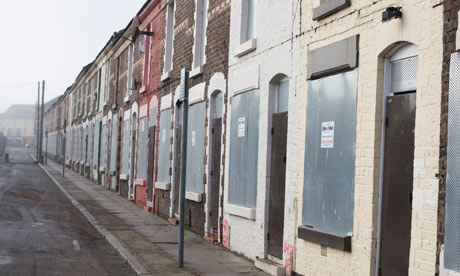August 13, 2012
Liverpool’s Homebaked community land trust is a model for local rebuilding in the wake of failed regeneration projects

Venice Street, Liverpool, earmarked for a regeneration scheme that is now at risk of cancellation because of funding cuts. Photo: Colin Mcpherson
Directly in front of north Liverpool’s Homebaked community land trust sits Anfield stadium; behind it lies a ladder of tinned-up houses and several acres of rubble. Market triumph dominates one side of the road while market failure defines the other. The area has lived for 11 years with the disruption of “regeneration”, which in reality has meant the demolition of homes under a Housing Market Renewal scheme with no “market renewal” in sight.
Entering the trust’s premises, a disused baker’s shop, feels like finding a safe haven from wilful destruction, where, with extraordinary resilience, local residents plan to rebuild their neighbourhood “brick by brick, loaf by loaf”. Inside, a circle of canvas chairs are set up next to a kettle, mugs and a biscuit tin, and next to that, a corrugated cardboard model of the four flats the trust plans to refurbish and bring back into use at the same time as the bakery, which was a local institution until being forced into closure in late 2010.
Homebaked began life as 2Up2Down, an art project by the Dutch artist Jeanne van Heeswijk that was commissioned for the 2010 Liverpool Biennial. Van Heeswijk initially worked with a group of 40 young people from the Anfield area to design four new homes – all within or adjacent to the bakery building – and amenities for their half-gutted neighbourhood.
Her project found a permanent site when Mitchells Bakery closed and ownership of the premises transferred to Liverpool city council and became a community land trust (CLT) as a way of ensuring, crucially, that any decisions made by residents actually belonged to them, and couldn’t be altered or compromised by outside parties. Homebaked won the 2012 CLT award for excellence in community engagement for just this reason.
The fact that a group of volunteers have been able to save sound homes from demolition and make them available for use by the community suggests that the CLT model could work as an alternative to simply waiting for a government in denial, and a construction industry in slump, to build more houses.
As the regeneration expert John Houghton notes, it is becoming more, not less, difficult under the coalition for local authorities to bring empty homes (of which there are nearly a million) back into use, as budget cuts mean that staff can’t be spared to do the necessary legal, administrative and practical work.
The stated aims of the CLT Network are to meet housing need and to ensure that any housing built or maintained through a community land trust remains affordable in perpetuity, not just for as long as it is kept off the open market. (One problem of shared ownership, and of the coalition’s revival of the right to buy, is that affordable housing can be lost to the open market within a few years of being built.)
The human cost of failed regeneration schemes is hard to quantify, largely because what’s left behind, after the money has been promised, the bulldozer engaged and the money withdrawn, is an eerie silence. Those who haven’t been “decanted” from their homes into surrounding areas in advance of demolition are driven behind their front doors as the wrecking ball comes closer, entrenching mistrust and suspicion of top-down decision makers.
But in order for the CLT model to work there has to be a bottom line of knowledge, confidence and collective goals. The ability to say, first, “we know someone who can help us”, and then, “let’s give them a call” is more valuable than money. Rural CLTs tend to be formed by the better-off, or can at least call on the skills of more affluent and well-connected members of the local community.
This is where the multiple role of the bakery comes in: it will act – and in some ways already does act – as a meeting place, confidence-builder, skills provider, and employer rolled into one. Volunteers and staff are coming to be known locally as “the housing people”, who may be able to find something for grown-up children who want to live near, but not with, their parents or who can prevent older people from having to move out of the area they know.
This answers an obvious question about housing need: just because there is a “weak housing market” in an area doesn’t mean that there is no need for affordable housing in that area. In places with few and low-paying jobs, market rates, though lower, are still out of reach.
Homebaked CLT needs approximately £50, 000 per dwelling to turn it into someone’s home. Funding comes from a variety of charitable foundations and independent donors. It is applying to acquire the freehold of two adjacent terrace house from the city council. There are hundreds of tinned-up houses in the area awaiting demolition.
If the Anfield project is anything to go by, community land trusts are a way – as symbolic as they are practical – to circumvent the housing crisis, if only one home at a time.
Source: The Guardian

Leave a Reply